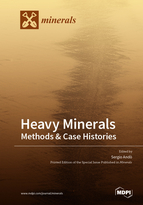Heavy Minerals: Methods & Case Histories
A special issue of Minerals (ISSN 2075-163X). This special issue belongs to the section "Mineral Deposits".
Deadline for manuscript submissions: closed (31 May 2019) | Viewed by 85046
Special Issue Editor
Interests: heavy-minerals; provenance studies; Raman spectroscopy; single grain analysis; varietal studies; Indus Fan; African sand; silt; dust
Special Issue Information
“Our chance of making correct provenance diagnoses becomes small when geological age blurs our landmarks, and the complexity of natural systems confounds us in a labyrinth of possibilities... Different techniques provide distinct points of view, from which disparate details of the general picture can be revealed. Only by the painstaking careful integration of such diverse complementary pieces of information can we hope to get a glimpse of the entire landscape.” Eduardo Garzanti, 2016. From static to dynamic provenance analysis—Sedimentary petrology upgraded. Sedimentary Geology 336, 3–13.
Dear Colleagues,
The principal aim of this book is to provide a wide range of information and a useful reference for researchers interested to investigate heavy-mineral assemblages in different geological settings and for a variety of purposes. The great methodological developments achieved in recent years for the identification of heavy minerals in a wide grain-size range will be illustrated. All factors that affect heavy-mineral concentration and relative proportions, including hydraulic sorting, mechanical abrasion, chemical weathering and post-depositional dissolution, and all factors able to introduce analytical, environmental or diagenetic bias will be thoroughly dealt with. A proper integration of multiple techniques including bulk-sediment, multi-mineral, and single-mineral methods will be discussed by renowned authors in their invited contributions.
Prof. Dr. Sergio Andò
Guest Editor
Manuscript Submission Information
Manuscripts should be submitted online at www.mdpi.com by registering and logging in to this website. Once you are registered, click here to go to the submission form. Manuscripts can be submitted until the deadline. All submissions that pass pre-check are peer-reviewed. Accepted papers will be published continuously in the journal (as soon as accepted) and will be listed together on the special issue website. Research articles, review articles as well as short communications are invited. For planned papers, a title and short abstract (about 100 words) can be sent to the Editorial Office for announcement on this website.
Submitted manuscripts should not have been published previously, nor be under consideration for publication elsewhere (except conference proceedings papers). All manuscripts are thoroughly refereed through a single-blind peer-review process. A guide for authors and other relevant information for submission of manuscripts is available on the Instructions for Authors page. Minerals is an international peer-reviewed open access monthly journal published by MDPI.
Please visit the Instructions for Authors page before submitting a manuscript. The Article Processing Charge (APC) for publication in this open access journal is 2400 CHF (Swiss Francs). Submitted papers should be well formatted and use good English. Authors may use MDPI's English editing service prior to publication or during author revisions.
Keywords
- heavy-mineral suites
- source-to-sink studies
- petroleum exploration
- advanced techniques of mineral analysis
- applications to provenance of silt and dust






